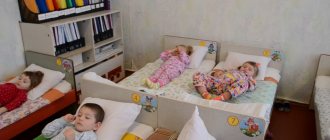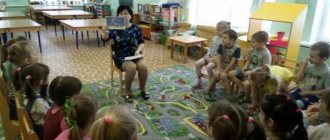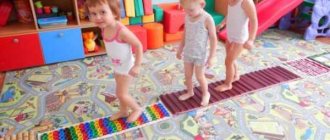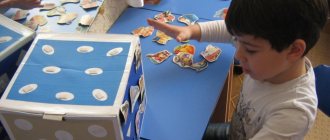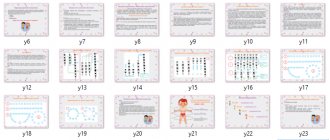Breathing exercises
An important part of awakening is correct breathing, which can be achieved using a number of special manipulations:
- clicking his tongue, parodying horses;
- active giggling;
- inflating a ball: a deep breath is followed by a uniform release of air, while children spread their arms to the sides, imitating inflating a ball; finish the exercise with a clap as a sign of the bursting of the balloon;
- dragon: active inhalations through the nose and exhalations through the mouth;
- snake: attempts to touch the tip of the nose and chin with the tongue;
- cow: exhalations should be smooth, measured, accompanied by a drawn-out “moo-oo”;
- steam locomotive: with their arms bent at the elbows, children walk one after another around the room (cars), while saying “chuh-chuh-chuh.”
All these exercises are aimed at strengthening and stimulating the respiratory tract, ensuring ventilation of the lungs.
Meaning and benefits
Each child is individual, and if one easily wakes up after a lunchtime nap, for another it can become a real challenge. Therefore, in many kindergartens, teachers use a gymnastics complex that helps children quickly return to active mode. The main goal of such activities is to get the child accustomed to the skills of doing exercises, which in the future will form the habit of daily healthy exercises.
To make it easier for the student to accept new things, gymnastics is carried out in a group of children. When other children are nearby with the child, it is easier for him to understand the essence of the tasks, and if something turns out to be incomprehensible, you can always learn from the example of friends. In addition to building team spirit, exercise is very beneficial for health, as it affects all systems of the body:
- increases immunity;
- builds resistance to stressful situations;
- stimulates the nervous and respiratory systems;
- accelerates metabolic processes;
- accelerates blood circulation;
- optimizes the functioning of the cardiovascular system;
- trains muscles, toning them;
- prevents the appearance of flat feet and curvature of posture;
- develops fine motor skills and coordination of movements;
- increases cognitive abilities;
- improves mood.
Attention! Exercising after a nap should be done an hour before meals or some time after meals. A ventilated room without drafts should be chosen as a location.
Organization of gymnastics
All manipulations carried out with children must be carefully considered and comply with the Federal State Educational Standard (FSES) (federal state educational standards). This is a set of clear rules and requirements for education at a certain level. For the physical development of preschool children, there is a “Program for the training and education of preschool children,” which reflects the rules for conducting exercises for various groups, taking into account the age, physical and psychological development of children.
When organizing gymnastics, the teacher is guided by the following criteria:
- age;
- physical abilities of children;
- load distribution;
- complexity of exercises;
- duration;
- location.
Age
Taking into account this indicator, the set of exercises after lunch sleep differs. So, for younger children, exercises are carried out in a playful way, and the kids pretend to be birds, animals, and mother’s helpers. In this case, the teacher must complete each of the “exercises.”
In the preparatory group, children aged 5–6 years are more organized and independent, so the teacher can appoint the “eldest” child who will show the exercises to the whole group, and the rest of the children will repeat them. At this time, the teacher can devote time to individual work with specific children.
In the preparatory group, children remember the exercises performed daily, so they often practice doing warm-ups on their own.
Load distribution
A standard set of exercises is performed for 15–20 minutes. The distribution of the load is affected by curvature of posture, flat feet and other physiological problems. If there are none, the general scheme looks like this:
| Stage number | What to do | Description of the exercise | Duration (min.) |
| 1 | Arm and leg stretches | Performed in bed, immediately after waking up. You can continue the exercise in the form of alternate swings of arms and legs near the bed | 3 |
| 2 | Walking | The transition to the active phase continues with walking, from slow to gradually accelerating. You can start in a cool room | 3 |
| 3 | Active body movements | Movements to prevent problems of the musculoskeletal system are continued in a warm room. This can be active swings, bending, body turns, jumping, squats. It is recommended to supplement with sports equipment (skipping ropes, children's weights and dumbbells, etc.) | 5–7 |
| 4 | Breathing exercises | In a moderately cool room, exercise elements taken from breathing exercises | 3–4 |
Features of gymnastics by month
Gymnastics after sleep in the preparatory group takes approximately 10-15 minutes in duration.
In this short time it is impossible to carry out gymnastics covering all the muscles and systems of the body. For the comprehensive development of children, it is recommended to change the composition of activities after sleep every month. During this period, the guys will master all the exercises of the previous complex and begin to warm up and train new muscle groups. Changing gymnastics keeps children interested in classes throughout the year.
The following is a brief overview of several complexes that can replace each other monthly:
- The first group of exercises begins with running in a cold (19°C) room, followed by preventative exercises for flat feet.
- The next complex includes warming up while lying and sitting in bed, breathing and hardening exercises.
- Next, instead of breathing exercises, the complex includes aerobics accompanied by music.
- The fourth complex begins with a hardening run, followed by exercises to prevent posture.
Hardening
Hardenings are carried out if they are developed and reinforced by the preschool educational institution program. At the same time, the methods should be individually focused on each student, taking into account the health characteristics of each child. If there are many children in a group and an individual program is not possible, the following moderate hardening technique is recommended.
Some of the active exercises in the summer are carried out outdoors; in the colder season, children perform gymnastics in a cool room (18–20 °C) without shoes, wearing T-shirts and panties. Health-improving walking barefoot on rubber massage mats is carried out, alternating with steps into basins of water. You can complete the gymnastics complex by washing your face, hands, neck, and chest.
Hardening trains the body's defenses, which will make the child less susceptible to changing environmental factors
In summer, dousing with water at room temperature is acceptable. Children will also benefit from dosed sunbathing during the warm period from 9:00 to 11:00. The time should gradually increase from 3 to 20 minutes.
Near the cribs
- "Hammers
". I.p.: sitting, legs bent, arms supported behind the back, toes on the toes, hitting the floor with the left heel.
I.p.: o.s., Hands on the belt, rolling from toes to heels.
III. Breathing exercises . "Little Frog."
I.p. - main stand. Imagine how the frog makes quick, sharp jumps. Squat down slightly, sigh, push off and jump with both legs moving forward. As you exhale, slowly say “K-v-a-a-a.”
IV. Walking along the path of “Health”
Rules
Since the work is carried out with children, it is necessary to strictly adhere to these rules. Regularly ventilate the room in which children study. In the warm season, exercises are carried out in the fresh air. For exercises that are performed on the floor, you need to acquire special gymnastic mats.
Clothes and shoes for exercise should be practical and comfortable. There is a complete absence of synthetic fabrics; instead, natural, loose fit is recommended. Exercises should be carried out at the same time every day. This will develop a systematic approach and teach children responsibility and order. Follow the sequence of gymnastic exercises.
So that the classes do not seem monotonous and do not tire the child, periodically it is necessary to supplement the existing complex with something new. Children's exercises are not designed for strength training. Therefore, you need to choose movements aimed at developing flexibility, coordination and increasing tone. It is necessary to constantly monitor the child’s condition, avoiding holding his breath. It is worth completing the gymnastics before the child gets tired.
Carefully! Sudden jerky movements and quick rises from the bed are not allowed. This is fraught with dizziness, darkening of the eyes and stretching of rested muscles.



